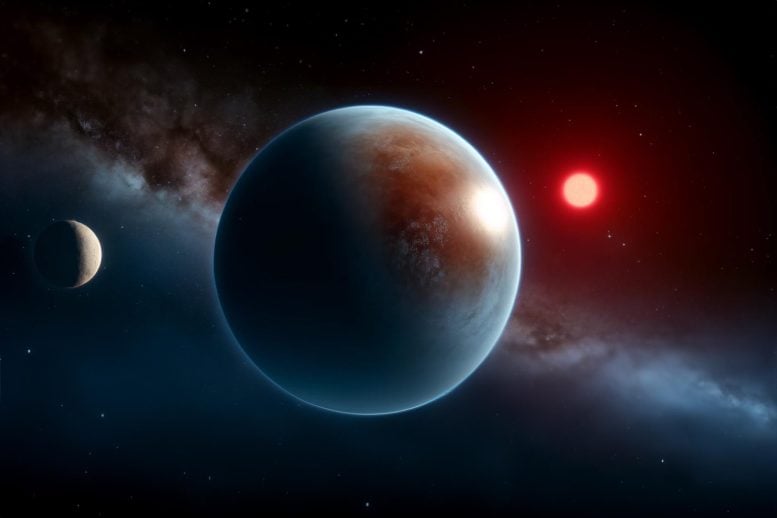
The discovery of Gliese 12 b, a Venus-like planet located just 40 light years away, offers new perspectives for understanding the conditions conducive to life in the universe. This “evil twin” receives much more radiation from its star than from Earth, posing intriguing questions for future research with advanced telescopes. Credit: SciTechDaily.com
Recent discoveries of a
” data-gt-translate-attributes=”({“attribute”:”data-cmtooltip”, “format”:”html”})” tabindex=”0″ role=”link”>VenusThe planet Gliese 12 b, similar to this one, enhances our search for planets suitable for life, allowing us to take a closer look at Earth’s potential “evil twins.”
The discovery of a Venus-like planet around a star near our solar system gives hope that astronomers will one day be able to unlock the secret of how life appeared on Earth.
The study of life in the Universe is difficult because we only have one example of a planet where life has been confirmed: Earth. It is difficult to say which features of the Earth are necessary for life to arise and which are irrelevant. Until we find a “twin Earth” where the conditions necessary for life have also arisen, the best astronomers can do is study “evil twins,” planets whose initial conditions are similar to those of Earth. and which turned out to be very different, with environments unfit for life.
Glimpses of the solar system and distant discoveries
In the solar system, Venus and
” data-gt-translate-attributes=”({“attribute”:”data-cmtooltip”, “format”:”html”})” tabindex=”0″ role=”link”>Mars Give two examples of lifeless “evil twins”. But with only two examples, there is still much uncertainty about how strict or lax living conditions are. Since the 1990s, more than 5,500 planets orbiting stars other than the Sun have been discovered. However, most of these planets are hundreds of light years from Earth, making it difficult to study them in detail.
Close encounter with Gliese 12 b
In this research, the team discovered and characterized a new planet, called Gliese 12 b, based on data from NASA’s TESS space telescope; the MuSCAT2 and MuSCAT3 cameras, developed by the Center for Astrobiology (ABC) in Japan and the University of Tokyo; and the Subaru Telescope of the National Astronomical Observatory of Japan. Gliese 12 b is close to the solar system, located only 40 light years in the direction of the Pisces concentration. This makes Gliese 12 b an ideal target to study with NASA’s James Webb Space Telescope and future 30m-class telescopes.
Characteristics and potential of the Gliese 12 b
So far, the international team led by scientists from the Japan Astrobiology Center, the University of Tokyo, the National Astronomical Observatory of Japan and the Tokyo Institute of Technology has discovered that Gliese 12 b had an orbital period, that is to say a year on the planet, of only 12.8 days. The planet has a radius that is only 4% smaller than the radius of Earth and is less than 3.9 times the mass of Earth. Gliese 12 b receives 1.6 times more radiation from its host star than Earth receives from the Sun. For comparison, Venus receives 1.9 times more radiation than Earth.
Conclusion and future research
Based on this data, the team believes that Gliese 12 b is an “evil twin”, resembling Venus more than Earth. But they cannot rule out the possibility that Gliese 12 b is an “Earth twin” with liquid water on its surface. Further observations will determine whether Gliese 12 b is an “evil twin” or an “earth twin”. In both cases, the study of Gliese 12 b will give us a better idea of the prerequisites for the appearance of an environment favorable to life on a planet.
To learn more about this discovery, see TESS’s Newest Discovery Could Change Our Search for Extraterrestrial Worlds.
Reference: “Gliese 12b: A temperate planet the size of Earth at 12 pc, ideal for atmospheric transmission spectroscopy” by Masayuki Kuzuhara, Akihiko Fukui, John H. Livingston, Jose A. Caballero, Jerome P. de Leon, Teruyuki Hirano, Yui Kasagi, Felipe Murgas, Norio Narita, Masashi Omiya, Jaume Orell-Miquel, Enric Palle, Quentin Changeat, Emma Esparza-Borges, Hiroki Harakawa, Coel Hellier, Yasunori Hori, Kai Ikuta, Hiroyuki Tako Ishikawa, Takanori Kodama, Takayuki Kotani, Tomoyuki Kudo, John C. Morales, Mayuko Mori, Evangelos Nagel, Hannu Parviainen, Volker Perdelwitz, Ansgar Reiners, Ignasi Ribas, Jorge Sanz-Forcada, Bun’ei Sato, Andreas Schweitzer, Hugo M. Tavernero, Takuya Takarada, Taichi Uyama, Noriharu Watanabe, Mathias Zechmeister, Nestor Abreu Garcia, Wako Aoki, Charles Beichman, Victor JS Bejar, Timothy D. Brandt, Jessica Calatayud-Borras, Ilaria Carleo, David Charbonneau, Karen A. Collins, Thayne Currie, John P. Doty, Stefan Dreizler Gareb Fernandez-Rodriguez, Izuru Fukuda, Daniel Galan, Samuel Geraldia-Gonzalez, Josaphat Gonzalez-Garcia, Yuya Hayashi, Christina Hedges, Thomas Henning, Klaus Hodapp, Masahiro Ikoma, Keisuke Isogai, Shane Jacobson, Markus Janson, Jon M. Jenkins, Taiki Kagetani, Eiji Kawai, Yugo Kawai, Kiyoe Kawauchi, Eiichiro Kokubo, Mihoko Konishi, Judith Korth, Vigneshwaran Krishnamurthy, Takashi Kurokawa, Nobuhiko Kusakabe, Jungmi Kwon, Andrew Laza-Ramos, Florence Libotte, Rafael Luque, Alberto Madrigal -Aguado, Yuji Matsumoto, Dimitri Mawet, Michael W. McElwain, Peter Paul Meni Gallardo, Giuseppe Morello, Sara Munoz Torres, Jun Nishikawa, Stevanus K. Nugroho, Masahiro Ogihara, Alberto Pelaez-Torres, David Rapetti, Manuel Sanchez-Benavente, Martin Schlecker, Sara Seager, Eugene Serabyn, Takuma Serizawa, Monika Stangret, Aoi Takahashi, Huan-Yu Teng, Motohide Tamura, Yuka Terada, Akitoshi Ueda, Tomonori Usuda, Roland Vanderspek, Sébastien Vievard, David Watanabe, Joshua N. Winn and Maria Rosa Zapatero Osorio, May 23, 2024, THE
” data-gt-translate-attributes=”({“attribute”:”data-cmtooltip”, “format”:”html”})” tabindex=”0″ role=”link”>Letters from the Astrophysical Journal.
DOI: 10.3847/2041-8213/ad3642
Funding: Japan Science and Technology Agency, Japan Society for the Promotion of Science, National Natural Science Foundation of China, Agencia Estatal de Investigación, European Union and National Investigation Agency of the Spanish Ministry of Science and Technology ‘Innovation, Center of Excellence’ Severo Ochoa and Maria de Maeztu Prize, Massachusetts Institute of Technology, Academic Mission Service, Spanish Ministry of Universities Margarita Salas Fellowship, Italian National Institute of Astrophysics, Swedish National Space Agency, Swedish Council of Research, Deutsche Forschungsgemeinschaft, National Aeronautics and Space Administration NExSS.